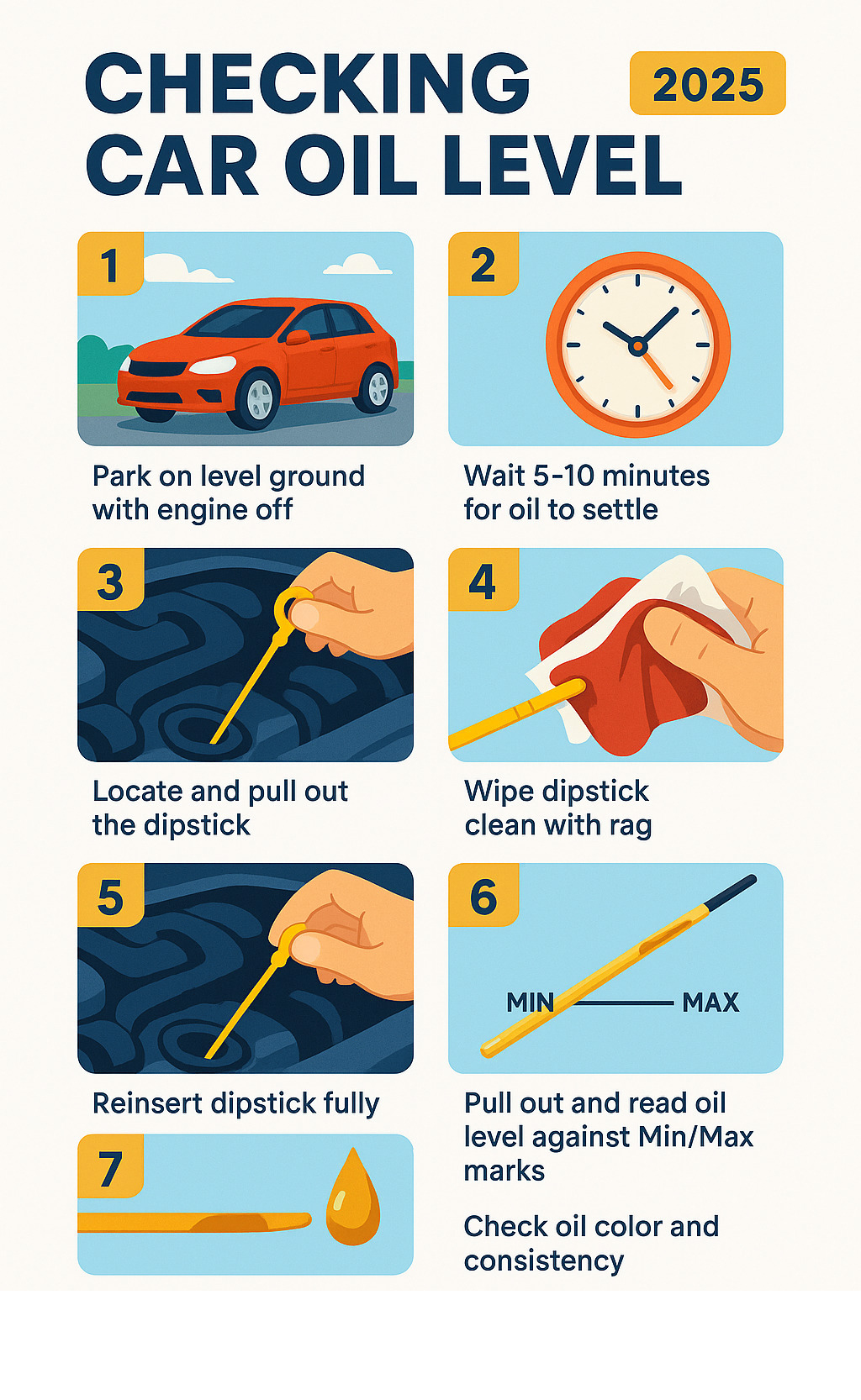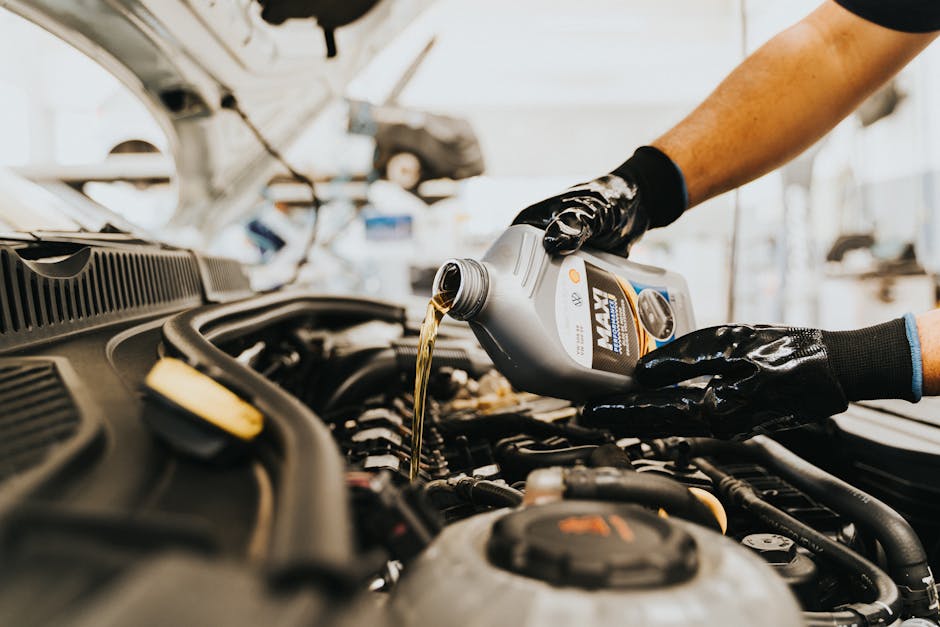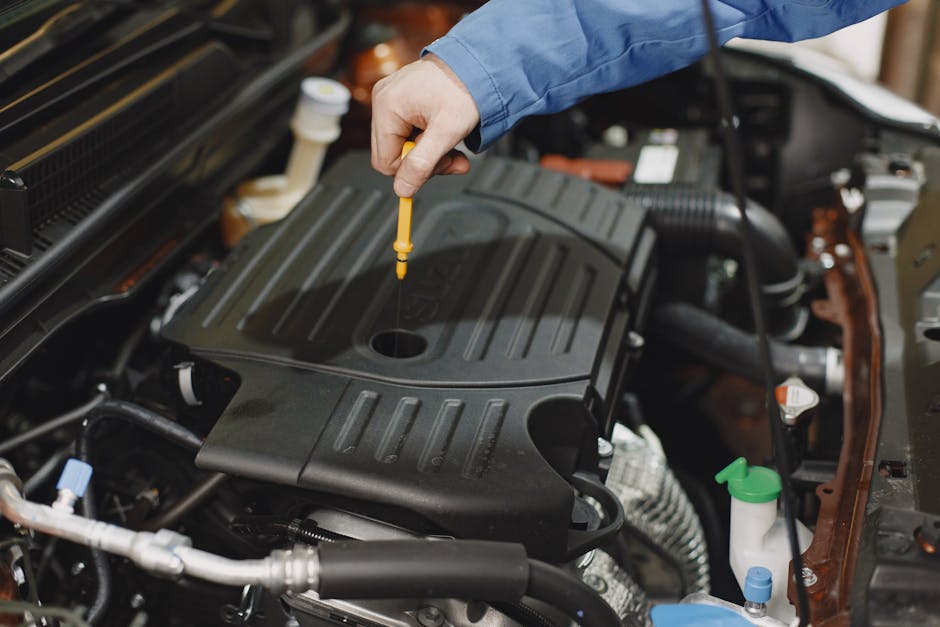Checking Car Oil Level: Master 2025 Guide
Why Your Engine’s Lifeblood Matters
Checking car oil level is one of the quickest, highest-return habits any driver can adopt. Motor oil keeps parts moving smoothly, carries away heat, and traps debris so your engine can live a long, trouble-free life. For a concise primer, see motor oil.
Quick Answer: How to Check Your Car’s Oil Level
- Park on level ground and turn off the engine
- Wait 5-10 minutes for oil to drain back
- Pull out the dipstick and wipe it clean
- Reinsert dipstick fully, then pull it out again
- Read the level between the Min/Max marks
- Check color—golden to amber is good; black, milky, or gritty signals trouble
Running low on oil can seize an engine and cost thousands, yet the prevention takes less time than a coffee break.
Why checking matters:
- Prevents damage from poor lubrication
- Spots leaks early
- Confirms when an oil change is due
- Adds miles and years to engine life
Most mechanics suggest a monthly check; high-mileage or performance cars may need a glance every other fill-up.
Whether you’re a tech enthusiast or simply want a dependable commuter, this easy habit keeps you firmly in charge of your car’s health.

The Step-by-Step Guide to Checking Car Oil Level
This section walks you through the process from preparation to an accurate reading.
Preparing for Checking Your Car Oil Level

Getting ready for checking car oil level is like setting up a scale—accuracy starts with a flat surface.
Find Level Ground
Park on a flat driveway or parking lot. A tilted vehicle lets oil pool to one side and throws off the reading.
Temperature Sweet Spot
Wait 5–10 minutes after shutting the engine off so oil drains back into the pan. A shorter 3–5 minute pause works in a pinch, but always follow your owner’s manual if it specifies hot or cold checking.
Tools & Safety
A clean rag or paper towel and an engaged parking brake are all you need. Be mindful of hot components under the hood.
For more guidance, see our Car Maintenance for Beginners guide.
Locating and Reading the Dipstick

Spot the Dipstick
Look for a yellow or orange handle marked “OIL.” Front-wheel-drive cars often place it near the front of the engine; rear-wheel-drive vehicles may tuck it toward the back.
Use the Proper Technique
- Pull the dipstick straight out.
- Wipe it clean end to end.
- Reinsert fully, then pull it out for the true reading.
Decode the Markings
Two dots, “MIN/MAX,” or a crosshatched area all say the same thing: keep the level between the marks. If it’s at or below the low mark, add oil—about a quart moves most cars from low to full.
Need more detail? Visit our How to Check Your Vehicle’s Oil Level resource.
Interpreting the Results: What Your Oil is Telling You
The dipstick doesn’t just measure quantity—it gives clues about oil quality and overall engine health.
Understanding Oil Level and Color

Level: Anywhere between the low and high marks is safe. Near the low mark means you’re about a quart down; below it, add oil immediately. Above the high mark can be harmful—too much oil foams and loses lubricating power.
Color & Consistency:
- Golden/amber: fresh and healthy
- Dark brown/black: used but normal—schedule a change soon
- Milky/cream: coolant contamination—stop driving and seek help
- Visible metal flakes: internal wear—get a professional inspection
A quick finger test helps: clean oil feels smooth, while gritty oil indicates it’s past its prime.
How Often Should You Check Your Oil?
The rule of thumb is once a month for modern cars, and every other fill-up for high-mileage or performance vehicles. Track consumption for a few weeks after buying a car; some engines naturally use more oil than others.
Long trips, extreme temperatures, or any sign of a leak justify extra checks. Even a brief monthly routine is far better than ignoring the dipstick altogether.
What to Do After Checking Your Car Oil Level
How to Properly Add Engine Oil

Match the viscosity on your oil cap or in the manual (e.g., 5W-30). Remove the filler cap, place a funnel, and add about half a quart. Wait a couple of minutes, re-check, and top up in small increments until the level sits safely between the marks.
The Dangers of Overfilling Your Engine
Too much oil lets the crankshaft whip it into foam, reducing lubrication and raising internal pressure. Warning signs include oil above the high mark, foamy oil on the dipstick, or blue exhaust smoke. If you overfill, drain the excess before driving.
When to Call a Professional
Seek expert help if you find milky oil, metal shavings, rapid oil loss, or if you simply aren’t comfortable performing the check. A modest inspection bill is far cheaper than a new engine.
For more maintenance wisdom, explore our Resource Guide section.
Frequently Asked Questions about Checking Engine Oil
Let’s tackle the most common questions we hear about checking car oil level. These are the real-world situations that leave drivers scratching their heads at gas stations and in their driveways.
What if my car doesn’t have a dipstick?
Don’t panic – you’re not going crazy! Some newer cars, particularly European models, have ditched the traditional dipstick for electronic oil monitoring systems. It’s like having a digital thermometer instead of the old mercury kind.
You can check your oil level through your vehicle’s infotainment screen or dashboard display. The exact steps vary by manufacturer – some require you to steer through menus, while others have dedicated buttons. Think of it as checking your phone’s battery level, but for your engine.
Here’s the catch: these systems often need specific conditions to give accurate readings. Some require the engine to be running and at operating temperature, while others work with the engine off. Your owner’s manual is your best friend here – it’ll tell you exactly how your specific system works.
These digital systems typically show oil level as a percentage or with visual indicators like bars or gauges. No more guessing what those dipstick marks mean!
How much oil consumption is considered normal?
This is where things get interesting – and where many car owners worry unnecessarily. Oil consumption varies significantly by manufacturer and engine type, and what’s normal might surprise you.
Most manufacturers consider consuming up to one quart of oil every 1,000 to 3,000 miles to be within normal range. That’s roughly 1 liter per 1,600 kilometers for our metric friends. For older vehicles or high-performance engines, this consumption can be even higher and still be perfectly normal.
High-performance engines and turbocharged units are particularly thirsty for oil by design. They work harder and run hotter, so they naturally consume more oil. It’s like comparing a marathon runner’s water consumption to someone sitting on the couch.
The key is watching for sudden changes. If your engine suddenly starts consuming significantly more oil than usual, that’s when you should have it checked for leaks or other issues. A gradual increase over time is more normal as engines age.
Does the oil have to be exactly on the ‘Full’ line?
Absolutely not! Your engine doesn’t need a perfect report card to run safely. The oil level doesn’t have to be at the high mark for your engine to have adequate lubrication.
As long as the oil level falls between the ‘Add/Min’ and ‘Full/Max’ marks, your engine is properly protected. Think of it like a fuel tank – you don’t need it completely full to drive safely, but you don’t want it running on empty either.
The space between these marks typically represents about one quart of oil in newer vehicles. Anywhere in this range is acceptable, though keeping it closer to the full mark gives you a larger safety margin before you need to add more.
How long should I wait after driving before checking oil?
The textbook answer is 10 minutes after shutting off the engine for the most accurate reading. But let’s be honest – life doesn’t always follow textbook rules.
Here’s the practical truth: a 3-5 minute wait is much better than not checking at all. If you’re at a gas station after filling up, those few minutes spent cleaning your windshield or grabbing a snack are usually sufficient for a reasonably accurate reading.
The goal is allowing enough time for the oil to drain back into the oil pan from the engine’s upper components. Hot oil flows faster than cold oil, so even a short wait after driving gives you a decent reading.
What should I do if I find oil leaks?
Oil spots under your car can be alarming, but don’t immediately assume the worst. First, determine the severity of the situation. Small, occasional drips might not be immediately dangerous, but persistent puddles need attention.
Start by checking your oil level more frequently – daily if necessary – until you understand how much oil you’re losing. Keep a mental note of how quickly the level drops after adding oil.
For expensive leak repairs, you might temporarily manage by checking oil frequently and keeping extra oil in your trunk. However, environmental concerns and the inconvenience usually make repair the better long-term solution.
Red flag situations that need immediate attention include large puddles, rapidly dropping oil levels, or leaks that suddenly appear after being fine for months.
Can I mix different types of oil?
In an emergency, yes – but it’s not ideal. You can mix different oil types temporarily, but there are some important guidelines to follow.
Stick to the same viscosity grade (like 5W-30) and try to use the same type (conventional, synthetic blend, or full synthetic) when possible. Different oil formulations have different additive packages that may not work optimally together – like mixing different brands of paint.
Think of it as a temporary band-aid solution. For regular maintenance, always use the oil type and grade specified in your owner’s manual for best performance and engine protection. Your engine was designed with specific oil characteristics in mind, and following those specifications ensures optimal performance and longevity.
Conclusion: Become Your Car’s Best Friend
Congratulations! You’ve just mastered one of the most valuable skills any car owner can have. Checking your car’s oil level regularly isn’t just maintenance – it’s becoming your vehicle’s best friend and protector.
Think about it this way: for just five minutes of your time each month, you’re potentially saving thousands of dollars and countless hours of frustration. That’s a pretty incredible return on investment, wouldn’t you agree?
The habit that pays dividends starts simple. Whether you’re filling up at the gas station or washing your car in the driveway, make oil checking part of your routine. Your engine doesn’t care if you drive a weekend track car or a daily commuter – it needs that liquid gold to keep running smoothly.
What makes the difference between car owners who face expensive engine repairs and those who don’t? It’s often this simple habit. The drivers who check their oil regularly catch problems early, add oil when needed, and notice changes before they become catastrophes.
You’re not just looking for low oil levels. You’re also watching for color changes, unusual consistency, and warning signs that could indicate bigger problems. That milky appearance or those metal particles we talked about? Catching them early through regular checking can mean the difference between a minor repair and a complete engine rebuild.
Your confidence grows every time you pop that hood and pull out the dipstick. What once seemed intimidating becomes second nature. You’ll start noticing things about your car that you never paid attention to before – and that awareness makes you a better, more informed driver.
At Car News 4 You, we believe that understanding your vehicle connects you to the broader automotive culture we all love. Whether you’re passionate about racing leagues, luxury sports cars, or just want your daily driver to last another 200,000 miles, it all starts with taking care of the basics.
The peace of mind that comes from knowing your engine is properly lubricated is priceless. No more wondering if that engine noise is serious. No more anxiety about long road trips. No more surprise breakdowns that could have been prevented.
For comprehensive vehicle care that goes beyond the basics, explore our Ultimate Guide to Car Maintenance for 2025: From Basic to Advanced. Your journey into automotive knowledge is just beginning, and we’re here to guide you every step of the way.
Your engine is counting on you – and now you know exactly how to be there for it. Welcome to informed car ownership, where a simple dipstick check becomes your vehicle’s lifeline.







